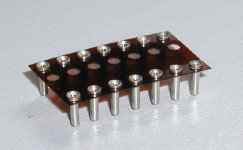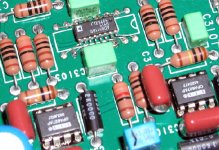ML vs BOSOZ
As always great work guys, your preamp is awesome! With respect only to sound quality, how would this ML clone compare to the BOSOZ or BOZ???
Thanks
Tom
As always great work guys, your preamp is awesome! With respect only to sound quality, how would this ML clone compare to the BOSOZ or BOZ???
Thanks
Tom
How do you measure the outer foil is on which pin?
You apply a signal across the cap and place the cap in a paperclip 'holder'. Measure the induced signal in the paperclip with a scope and reverse polarity from the signal generator. The higher measurement corresponds to the outer foil of the cap being connected to signal.
A lot of caps, even boutique types, are not consistently marked from the manufacturer.
Algar_emi said:How do you measure the outer foil is on which pin?
Thanks.
It's been also explained in this thread: http://www.diyaudio.com/forums/showthread.php?s=&threadid=7593&perpage=25&highlight=&pagenumber=3
Re: ML vs BOSOZ
I prefer (the tweaked version) to BOZ, never tried BOSOZ, never really tweaked BOZ😉
raincheck said:With respect only to sound quality, how would this ML clone compare to the BOSOZ or BOZ???
I prefer (the tweaked version) to BOZ, never tried BOSOZ, never really tweaked BOZ😉
Hey Peter, two things.
1. Where can I buy those Vishay caps in USA?
2. You mentioned you bought 100 BG from Japan at 1/3 price. Where did you buy them? I'm also going to Tokyo by the end of this month, perhaps I can buy from your source directly.
Thanks
Sunny
1. Where can I buy those Vishay caps in USA?
2. You mentioned you bought 100 BG from Japan at 1/3 price. Where did you buy them? I'm also going to Tokyo by the end of this month, perhaps I can buy from your source directly.
Thanks
Sunny
Hi Carlos,
Talking about the bypass caps on the opamps. There is no ground pin on those opamps, do I need to use a wire to ground it to the PCB? Thanks,
Sunny
Talking about the bypass caps on the opamps. There is no ground pin on those opamps, do I need to use a wire to ground it to the PCB? Thanks,
Sunny
Sunsun22 said:Hi Carlos,
Talking about the bypass caps on the opamps. There is no ground pin on those opamps, do I need to use a wire to ground it to the PCB? Thanks,
Sunny
Yes, there is no ground pin.
You need to find a ground as near as possible from the op-amp.
Sometimes one of the original PSU caps is near, the other one is far away.😀
Or you may have a ground line passing nearby.
Use your DMM if in doubt.
The worse the layout, the more difficult to do this.🙄
Sunsun22 said:Hey Peter, two things.
1. Where can I buy those Vishay caps in USA?
2. You mentioned you bought 100 BG from Japan at 1/3 price. Where did you buy them? I'm also going to Tokyo by the end of this month, perhaps I can buy from your source directly.
Thanks
Sunny
I got some BG caps at 1/3rd price from a private seller in Indonesia, but I was too slow and didn't get enough of them and he is out of stock by now.
When ordering from Japan (in large quantities) you don't pay that low. Usually you end up paying 70-75% of what Percy or Partsconnexion is charging (after shipping cost and money transfers). It doesn't make sense to order in low quntities, as wiring money and shipping costs are rather high.
Also, in recent times, the prices from regular distributors have dropped by at least 25% (on BGs), while prices from Japan didn't change. Takeda Machinery is a Japanese distributor, and I believe they are listed on Jelmax site.
Quite often, when I'm out of some BG caps, I buy directly from Partsconnexion, which are 20 min drive from my place.
Blue Vishay/ROE caps are available from Mouser (in USA).
Sockets........?
Both op amps and decoupling caps in sockets? You are adding parasitic inductance and ESR that are greater than that of the cap itself. Not only will this move the resonant point of the caps and add damping, changing the way the film bypass cap interacts with the other filter caps, but it can move them to a point where they sound better when in the sockets (for awhile until the leads oxidize and the socket ESR changes over time).
This might even be complete waste of time to see how the capacitor is going to sound when soldered in to the board. You had better test the film cap with the exact type op electrolytic that you going to use since even changing the size for a given electrolytic of the same brand, voltage and capacitance will move the resonances to different frequencies and Q's. I know it is probably quick and dirty, but is more dirty than quick.
How long does it take to solder a capacitor in than stick it in a socket? I think I might be paying more attention to Carlos about decoupling. Doing this way will mislead you as often as not. I thought most of this had been covered on the forum. No offence intended but maybe a little more reading and less "leading" is in order?
Both op amps and decoupling caps in sockets? You are adding parasitic inductance and ESR that are greater than that of the cap itself. Not only will this move the resonant point of the caps and add damping, changing the way the film bypass cap interacts with the other filter caps, but it can move them to a point where they sound better when in the sockets (for awhile until the leads oxidize and the socket ESR changes over time).
This might even be complete waste of time to see how the capacitor is going to sound when soldered in to the board. You had better test the film cap with the exact type op electrolytic that you going to use since even changing the size for a given electrolytic of the same brand, voltage and capacitance will move the resonances to different frequencies and Q's. I know it is probably quick and dirty, but is more dirty than quick.
How long does it take to solder a capacitor in than stick it in a socket? I think I might be paying more attention to Carlos about decoupling. Doing this way will mislead you as often as not. I thought most of this had been covered on the forum. No offence intended but maybe a little more reading and less "leading" is in order?
Re: Re: Regulators
Peter, what is the voltage being used for the LM2937 and LM2990 combination. Are they pin-to-pin competable with the original regulators on the 38S PCB?
Sunny
Peter Daniel said:
I'm using LM2937 and LM2990. This is part of 38 to 380 upgrade, and they indeed sound much better than 78xx.
I never tried LT1963, yet.
Peter, what is the voltage being used for the LM2937 and LM2990 combination. Are they pin-to-pin competable with the original regulators on the 38S PCB?
Sunny
Re: Sockets........?
I don't know why, but it feels like I'm reading Fred Dieckmans' comment.
While what you say is true, but let me do things my way.
It doesn't take long to solder one capacitor, but it takes much longer to solder/desolder 20 capacitors, especially when you have to remove the board from a chassis to do that. If you are testing 60 caps it takes even longer. I'm not even mentioning 4 layer board and the chance of damaging it while desoldering.
And the difference between caps is very obvious even when mounted in sockets.
Desoldering op amp from this board is virtually impossible. I tried it once and I damaged through hole plating, I just cut it off now and desolder ea. pin separately. The sockets for op amps I'm using are special type, without any plastic parts and pins flush with a board.
MalichiConstant said:Both op amps and decoupling caps in sockets? You are adding parasitic inductance and ESR that are greater than that of the cap itself. Not only will this move the resonant point of the caps and add damping, changing the way the film bypass cap interacts with the other filter caps, but it can move them to a point where they sound better when in the sockets (for awhile until the leads oxidize and the socket ESR changes over time).
This might even be complete waste of time to see how the capacitor is going to sound when soldered in to the board. You had better test the film cap with the exact type op electrolytic that you going to use since even changing the size for a given electrolytic of the same brand, voltage and capacitance will move the resonances to different frequencies and Q's. I know it is probably quick and dirty, but is more dirty than quick.
How long does it take to solder a capacitor in than stick it in a socket? I think I might be paying more attention to Carlos about decoupling. Doing this way will mislead you as often as not. I thought most of this had been covered on the forum. No offence intended but maybe a little more reading and less "leading" is in order?
I don't know why, but it feels like I'm reading Fred Dieckmans' comment.
While what you say is true, but let me do things my way.
It doesn't take long to solder one capacitor, but it takes much longer to solder/desolder 20 capacitors, especially when you have to remove the board from a chassis to do that. If you are testing 60 caps it takes even longer. I'm not even mentioning 4 layer board and the chance of damaging it while desoldering.
And the difference between caps is very obvious even when mounted in sockets.
Desoldering op amp from this board is virtually impossible. I tried it once and I damaged through hole plating, I just cut it off now and desolder ea. pin separately. The sockets for op amps I'm using are special type, without any plastic parts and pins flush with a board.
Re: Re: Re: Regulators
Yes, they are and the voltage is +/-15V.
Sunsun22 said:
Peter, what is the voltage being used for the LM2937 and LM2990 combination. Are they pin-to-pin competable with the original regulators on the 38S PCB?
Sunny
Yes, they are and the voltage is +/-15V.
At a local surplus store😉
After removing plastic film, you don't even know the op amp IS in a socket. Still, after deciding which one to go with I'm removing that setup and solder op amp directly.
After removing plastic film, you don't even know the op amp IS in a socket. Still, after deciding which one to go with I'm removing that setup and solder op amp directly.
Peter Daniel said:Another pic for all of you, who like me don't like sockets. Check the way ADG411 switch is mounted. BTW, I didn't notice any improvement here, with this new IC.
Excellent job, whait until we replace MOTs here, that will change the entire thing. 😉
Trigon.
- Home
- Amplifiers
- Solid State
- Building Mark Levinson 38 preamp chassis from scratch

